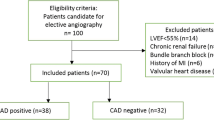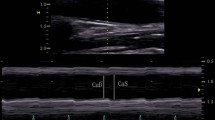Abstract
Aortic flow propagation velocity (APV) is a novel echocardiographic parameter used in coronary artery disease. It has also been used for the evaluation of aortic stiffness. In the present study, APV was measured in patients with ischemic and non-ischemic dilated cardiomyopathy (DCM) and was compared with the parameters of aortic stiffness such as aortic distensibility (AD) and aortic strain (AS). A total of 140 patients who had undergone coronary angiographic imaging were included in the study. Out of these patients, 44 had ischemic DCM, 46 had non-ischemic DCM, and 50 had normal coronary angiography (control group). AS, AD, and APV were calculated echocardiographically. One-way analysis of variance (ANOVA) and the Kruskal–Wallis test were used to compare continuous variables between the groups, while the categorical variables were compared using Pearson’s Chi square test. Pearson’s correlation test was used to investigate the parameters associated with APV, AS, and AD. Ischemic DCM and non-ischemic DCM groups differed significantly. The comparison of these groups with the control group, in terms of AS, AD, and APV values (ANOVA p < 0.001 for all) also showed a significant difference. APV was found to be significantly correlated with AS (r = 0.645, p < 0.001) and AD (r = 0.604, p < 0.001). In ROC analysis, the area under the curve (AUC) value for APV was 0.999 (p = 0.000) for detection of patients ischemic DCM and non-ischemic DCM. APV may be considered to be a novel and a simple echocardiographic marker, for both, distinguishing ischemic from non-ischemic DCM as well as for the presence of dilated cardiomyopathy with or without critical coronary artery disease.






Similar content being viewed by others
References
Textbook of Cardiovascular Medicine Eric J. Topol Lippincott Williams and Wilkins third edition turkish version 2008 Heart Failure and Transplantation Page 1330–1459
Manolio TA, Baughman KL, Rodeheffer R et al (1992) Prevalence and etiology of idiopathic dilated cardiomyopathy (summary of a National Heart, Lung, and Blood Institute workshop). Am J Cardiol 69:1458
Drexler H, Hayoz D, Munzel T, Hornig B, Just H, Brunner HR, Zelis R (1992) Endothelial function in chronic congestive heart failure. Am J Cardiol 69:1596–1601
Kubo SH, Rector TS, Bank AJ, Williams RE, Heifetz SM (1991) Endothelium-dependent vasodilation is attenuated in patients with heart failure. Circulation 84:1589–1596
Zhang H, Gao Z, Xu L, Yu X, Wong KCL, Liu H, Zhuang L, Shi P (2018) A meshfree representation for cardiac medical image computing. IEEE J Transl Eng Health Med 6:1800212. https://doi.org/10.1109/JTEHM.2018.2795022
Xu L, Huang X, Ma J, Huang J, Fan Y, Li H, Qiu J, Zhang H, Huang W (2017) Value of three-dimensional strain parameters for predicting left ventricular remodeling after ST-elevation myocardial infarction. Int J Cardiovasc Imaging 33(5):663–673. https://doi.org/10.1007/s10554-016-1053-3
Gheorghiade M, Bonow RO (1998) Chronic heart failure in the United States: a manifestation of coronary artery disease. Circulation 97:282–289
Fekler GM, Shaw LK, O’Connor CM (2002) A standardized definition of ischemic cardiomyopathy for use in clinical research. J Am Coll Cardiol 39:210–218
Lytle BW (2003) The role of coronary revascularization in the treatment of ischemic cardiomyopathy. Ann Thorac Surg 75:S2–S5
Oliver JJ, Webb DJ (2003) Noninvasive assessment of arterial stiffness and risk of atherosclerotic events. Arterioscler Thromb Vasc Biol 23:554–566
Zieman SJ, Melenovsky V, Kass DA (2005) Mechanisms, pathophysiology, and therapy of arterial stiffness. Arterioscler Thromb Vasc Biol 25:932–943
Stefanadis C, Wooley CF, Bush CA, Kolibash AL, Boudoulas J (1987) Aortic distensibility abnormalities in coronary artery disease. Am J Cardiol 59:1300–1304
Gunes Y, Tuncer M, Yildirim M et al (2008) A novel echocardiographic method for the prediction of coronary artery disease. Med Sci Monit 14:102–105
Gunes Y, Tuncer M, Guntekin U, Ceylan Y, Simsek H, Sahin M, Yildirim M (2010) The relation between the color M-mode propagation velocity of the descending aorta and coronary and carotid atherosclerosis and flow-mediated dilatation. Echocardiography 27(3):300–305
Parodi S, Izzotti A, Muselli M (2005) Re: the central role of receiver operating characteristic (ROC) curves in evaluating tests for the early detection of cancer. J Natl Cancer Inst 97(3):234–235 (author reply 235). https://doi.org/10.1093/jnci/dji034
Swets JA (1979) ROC analysis applied to the evaluation of medical imaging techniques. Invest Radiol 14(2):109–121. https://doi.org/10.1097/00004424-197903000-00002
Parikh R, Mathai A, Parikh S, Chandra Sekhar G, Thomas R (2008) Understanding and using sensitivity, specificity and predictive values. Indian J Ophthalmol 56(1):45–50. http://www.ncbi.nlm.nih.gov/pubmed/18158403. Accessed 25 April 2018
Deniz Ertorsun A, Bağ B, Uzar G, Turanoğlu A (2018) ROC (RECEIVER OPERATING CHARACTERISTIC) EĞRİSİ YÖNTEMİ İLE TANI TESTLERİNİN PERFORMANSLARININ DEĞERLENDİRİLMESİ. http://tip.baskent.edu.tr/kw/upload/600/dosyalar/cg/sempozyum/ogrsmpzsnm12/10.2.pdf. Accessed 30 April 2018
Guntekin U, Gunes Y, Gunes A, Ceylan Y, Gumrukcuoglu HA, Yucel Y, Simsek H, Tuncer M (2010) Noninvasive assessment of atherosclerosis in patients with isolated hypertension. Echocardiography 27(2):155–160
Güneş Y, Gümrükçüoğlu HA, Kaya Y, Tuncer M (2010) Incremental diagnostic value of color M-mode propagation velocity of the descending thoracic aorta to exercise electrocardiography. Turk Kardiyol Dern Ars 38(8):551–557
Chae CU, Pfeffer MA, Glynn RJ, Mitchell GF, Taylor JO, Hennekens CH (1999) Increased pulse pressure and risk of heart failure in the elderly. JAMA 281(7):634–639
Franklin SS, Larson MG, Khan SA, Wong ND, Kannel WB, Levy D (2001) Does the relation of blood pressure to coronary heart disease risk change with aging? The Framingham Heart Study. Circulation 103(9):1245–1249
Mitchell GF, Pfeffer MA, Braunwald E, Rouleau J-L, Bernstein V, Geltman EM, Flaker GC (1997) Sphygmomanometrically determined pulse pressure is a powerful independent predictor of recurrent events after myocardial infarction in patients with impaired left ventricular function. Circulation 96(12):4254–4260
Vaccarino V, Berger A, Abramson J, Black H, Setaro J, Davey J, Krumholz H (2001) Pulse pressure and risk of cardiovascular events in the systolic hypertension in the elderly program. Am J Cardiol 88(9):980–986
Kostis J, Lawrence-Nelson J, Ranjan R, Wilson A, Kostis W, Lacy C (2001) Association of increased pulse pressure with the development of heart failure in SHEP. Systolic Hypertension in the Elderly (SHEP) Cooperative Research Group. Am J Hypertens 14(8):798–803
Blacher J, Guerin AP, Pannier B, Marchais SJ, Safar ME, London GM (1999) Impact of aortic stiffness on survival in end-stage renal disease. Circulation 99(18):2434 – 2439
Forette F, Seux ML, Staessen JA, Thijs L, Birkenhager WH, Babarskiene MR, Babeanu S, Bossini A (1998) Prevention of dementia in randomised double-blind placebo-controlled Systolic Hypertension in Europe (Syst-Eur) trial. Lancet 352(9137):1347–1351
Author information
Authors and Affiliations
Corresponding author
Ethics declarations
Conflict of interest
The authors declare that they have no conflict of interest.
Rights and permissions
About this article
Cite this article
Gitmez, M. Investigation of elastic features of aorta and color M-mode flow propagation velocity (APV) of descending aorta in the patients with ischemic and non-ischemic dilated cardiomyopathy. Int J Cardiovasc Imaging 34, 1563–1570 (2018). https://doi.org/10.1007/s10554-018-1373-6
Received:
Accepted:
Published:
Issue Date:
DOI: https://doi.org/10.1007/s10554-018-1373-6




